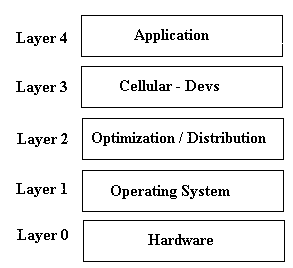 
|
 
|
| Goals |
The main goal of this project is the specification of cellular models based on asyncrhonous cell spaces using the DEVS formalism, and the development of simulation environments using this new paradigm. The proposal considers that each cell in the space is an atomic DEVS model, allowing the definition of continuous time cellular models. Each cell can have a precise timing definition using delay functions.
The basic idea is to simulate efficiently discrete events systems that can be described as cell spaces. High performance will be achieved using parallel execution with different synchronization mechanisms.

The idea is to provide a high level specification language for cellular models. In this way, a modeler without experience on DEVS models could be able to develop complex models and simulate them without knowing their internal representation. This technique allow automatic validation of the new models, improving the safety and development costs of the simulations.
Besides the cellular models, different kind of applications can be modeled, from industrial environments up to educational applications.
| Expected Results |
[ ToC ][ Top ] |
The main practical goal is to provide an environment for modelling and simulation of discrete event systems allowing a user to easily describe a model (using model bases, hierarchical descriptions and modular models), and to simulate it. In this project we will face the application of this environment in the modelling and simulation of complex urban traffic models. The goal is to execute microsimulations to solve congestion problems, traffic light synchronization, improvement of traffic flow using new traffic rules, etc.
The implementation of such an environment will have the base of a theoretical study regarding methodological aspects, considering concepts and procedures to specify, describe, represent and communicate different models in the same system.
An environment with these features can be applied directly in different problems, because the user can specify the model using a high level specification language. The models can be validated automatically, and besides, the models are independent of the simulation techniques.
From the theoretical point of view, the formal definitions presented in the Introduction are being finished. At present new algorithms for syncrhonization in parallel/distributed environments are being introduced. Experimental evaluation of the new proposals will be faced, in such a way to obtain a parallel simulation environment that can be used as a basis for different distributed applications. The main emphasis will be put in Cell-DEVS models.
The tools can be applied in different problems:
[
Information |
Courses |
Thesis |
Events ]
[
Student's work |
Goals |
Details of the Results |
Technical Assistance ]
Comments: Gabriel A. Wainer -
Webmaster: Sebastian Enrique
Last Update: September 28, 1999